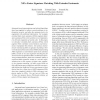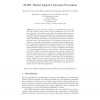138 search results - page 20 / 28 » Temporal Signatures for Intrusion Detection |
SP
2008
IEEE
14 years 3 months ago
2008
IEEE
Automata-based representations and related algorithms have been applied to address several problems in information security, and often the automata had to be augmented with additi...
ACSAC
2002
IEEE
14 years 1 months ago
2002
IEEE
The threat to organisations from network attacks is very real. Current countermeasures to denial of service (DoS) attacks rely on the perimeter model of network security. However,...
CCS
2003
ACM
14 years 1 months ago
2003
ACM
Web-based vulnerabilities represent a substantial portion of the security exposures of computer networks. In order to detect known web-based attacks, misuse detection systems are ...
NIPS
2007
13 years 10 months ago
2007
Current computational models of bottom-up and top-down components of attention are predictive of eye movements across a range of stimuli and of simple, fixed visual tasks (such a...
RAID
2005
Springer
14 years 2 months ago
2005
Springer
Intrusion detection systems are fundamentally passive and fail–open. Because their primary task is classification, they do nothing to prevent an attack from succeeding. An intru...


